Business Start-up Project: Financial, Legal, and Operational Planning
VerifiedAdded on 2023/01/16
|12
|2980
|49
Project
AI Summary
This project report delves into the critical aspects of starting a business in the UK, focusing on legal and financial compliance. It begins by outlining the requirements for tax payments and submissions to HMRC, including the processes for registration and the consequences of non-compliance. The report then explores various employment, health and safety, data protection, and digital and copyright legislation that businesses must adhere to. A significant portion is dedicated to cash flow forecasting, providing a structure and a completed forecast for a sole trader, along with an assessment of its implications. The report also differentiates between cash flow, turnover, and profit and identifies essential information required for understanding customers and suppliers. Furthermore, it emphasizes the importance of accurate invoices and payment receipts, providing templates for both. The report concludes by explaining the use and benefits of a business plan, its key contents, and the importance of a contingency plan, culminating in a sample business plan and a reflection on its creation. The project covers topics ranging from financial planning to legal compliance and operational strategies, providing a comprehensive overview of business start-up essentials.

Project-2
Paraphrase This Document
Need a fresh take? Get an instant paraphrase of this document with our AI Paraphraser
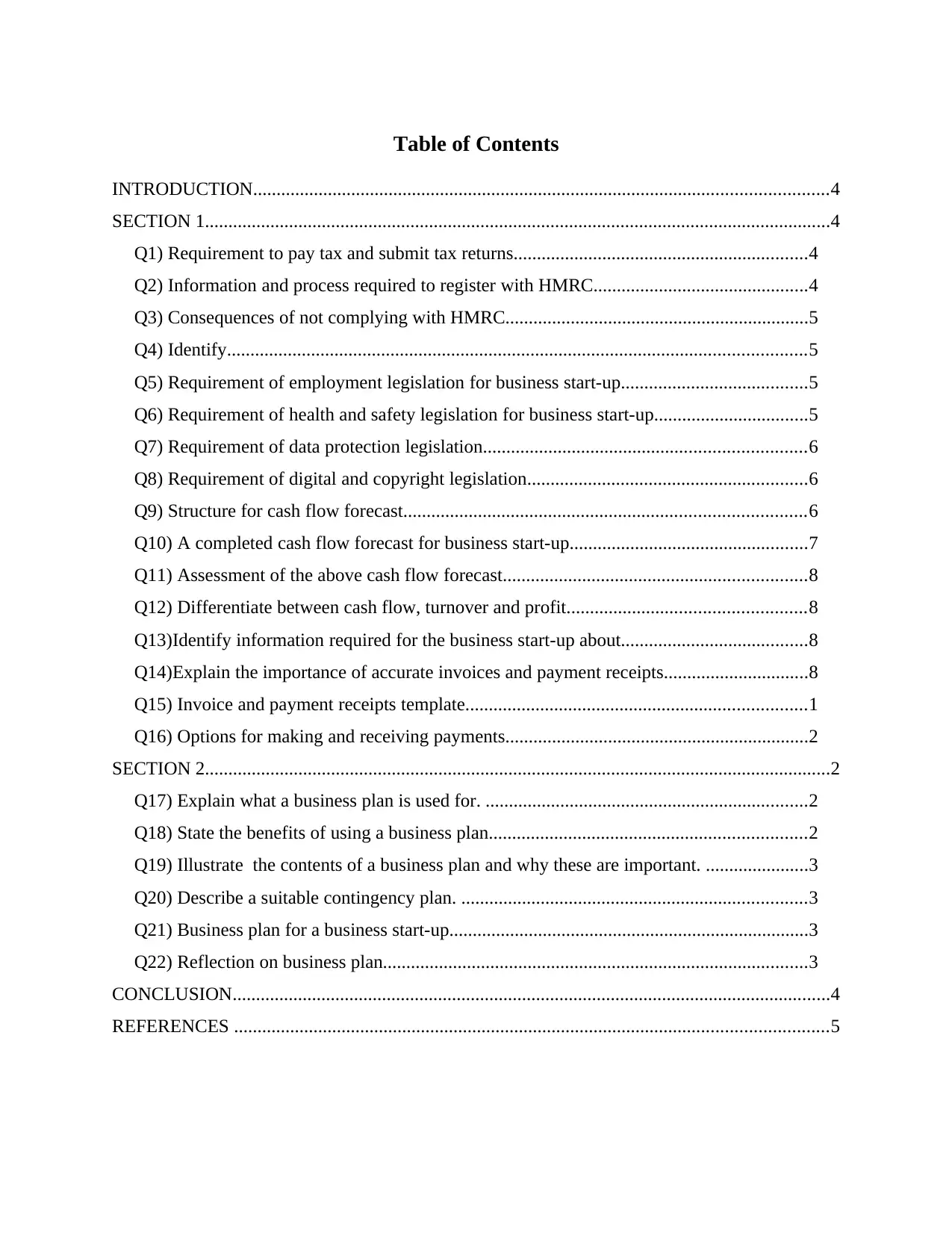
Table of Contents
INTRODUCTION...........................................................................................................................4
SECTION 1......................................................................................................................................4
Q1) Requirement to pay tax and submit tax returns...............................................................4
Q2) Information and process required to register with HMRC..............................................4
Q3) Consequences of not complying with HMRC.................................................................5
Q4) Identify............................................................................................................................5
Q5) Requirement of employment legislation for business start-up........................................5
Q6) Requirement of health and safety legislation for business start-up.................................5
Q7) Requirement of data protection legislation.....................................................................6
Q8) Requirement of digital and copyright legislation............................................................6
Q9) Structure for cash flow forecast......................................................................................6
Q10) A completed cash flow forecast for business start-up...................................................7
Q11) Assessment of the above cash flow forecast.................................................................8
Q12) Differentiate between cash flow, turnover and profit...................................................8
Q13)Identify information required for the business start-up about........................................8
Q14)Explain the importance of accurate invoices and payment receipts...............................8
Q15) Invoice and payment receipts template.........................................................................1
Q16) Options for making and receiving payments.................................................................2
SECTION 2......................................................................................................................................2
Q17) Explain what a business plan is used for. .....................................................................2
Q18) State the benefits of using a business plan....................................................................2
Q19) Illustrate the contents of a business plan and why these are important. ......................3
Q20) Describe a suitable contingency plan. ..........................................................................3
Q21) Business plan for a business start-up.............................................................................3
Q22) Reflection on business plan...........................................................................................3
CONCLUSION................................................................................................................................4
REFERENCES ...............................................................................................................................5
INTRODUCTION...........................................................................................................................4
SECTION 1......................................................................................................................................4
Q1) Requirement to pay tax and submit tax returns...............................................................4
Q2) Information and process required to register with HMRC..............................................4
Q3) Consequences of not complying with HMRC.................................................................5
Q4) Identify............................................................................................................................5
Q5) Requirement of employment legislation for business start-up........................................5
Q6) Requirement of health and safety legislation for business start-up.................................5
Q7) Requirement of data protection legislation.....................................................................6
Q8) Requirement of digital and copyright legislation............................................................6
Q9) Structure for cash flow forecast......................................................................................6
Q10) A completed cash flow forecast for business start-up...................................................7
Q11) Assessment of the above cash flow forecast.................................................................8
Q12) Differentiate between cash flow, turnover and profit...................................................8
Q13)Identify information required for the business start-up about........................................8
Q14)Explain the importance of accurate invoices and payment receipts...............................8
Q15) Invoice and payment receipts template.........................................................................1
Q16) Options for making and receiving payments.................................................................2
SECTION 2......................................................................................................................................2
Q17) Explain what a business plan is used for. .....................................................................2
Q18) State the benefits of using a business plan....................................................................2
Q19) Illustrate the contents of a business plan and why these are important. ......................3
Q20) Describe a suitable contingency plan. ..........................................................................3
Q21) Business plan for a business start-up.............................................................................3
Q22) Reflection on business plan...........................................................................................3
CONCLUSION................................................................................................................................4
REFERENCES ...............................................................................................................................5
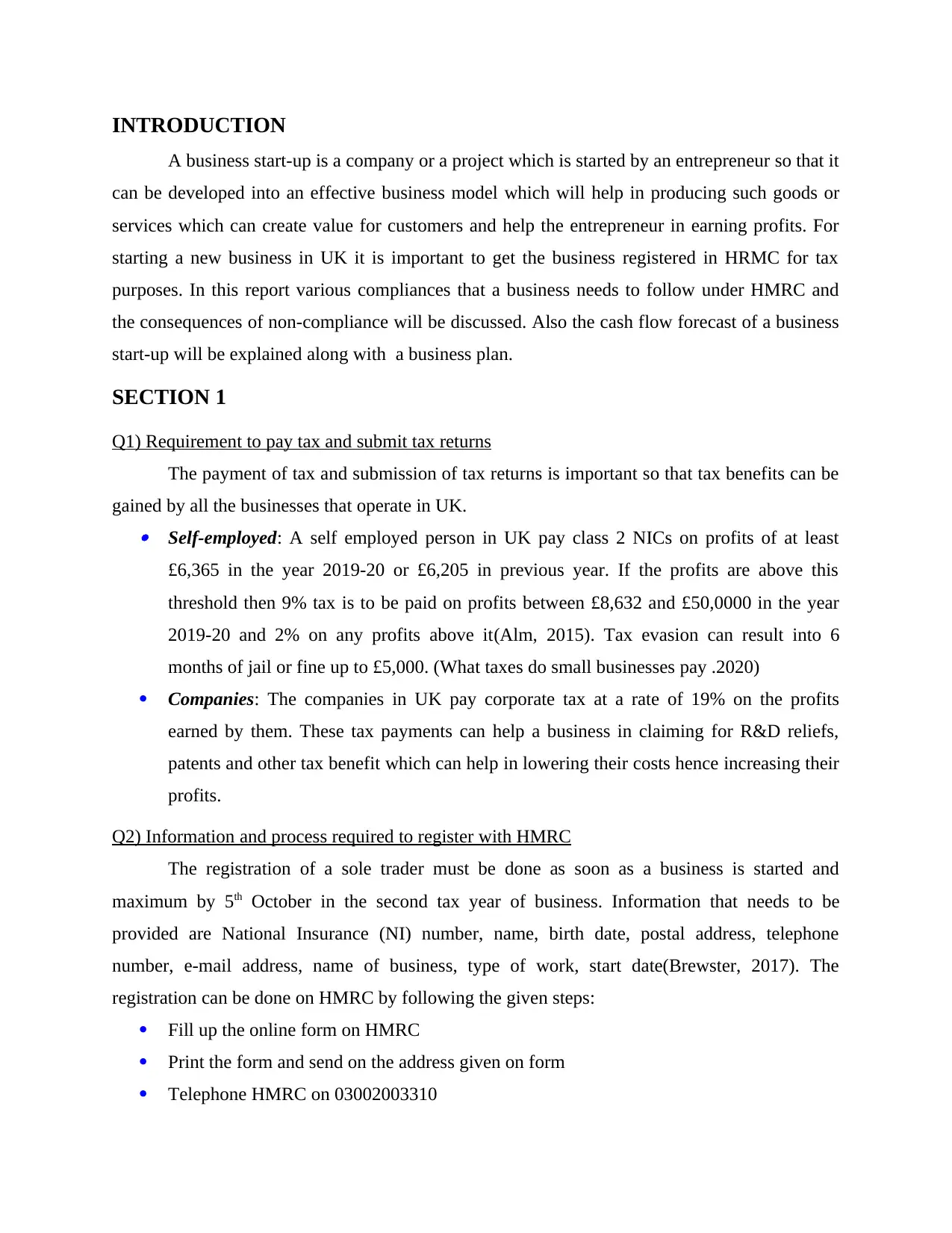
INTRODUCTION
A business start-up is a company or a project which is started by an entrepreneur so that it
can be developed into an effective business model which will help in producing such goods or
services which can create value for customers and help the entrepreneur in earning profits. For
starting a new business in UK it is important to get the business registered in HRMC for tax
purposes. In this report various compliances that a business needs to follow under HMRC and
the consequences of non-compliance will be discussed. Also the cash flow forecast of a business
start-up will be explained along with a business plan.
SECTION 1
Q1) Requirement to pay tax and submit tax returns
The payment of tax and submission of tax returns is important so that tax benefits can be
gained by all the businesses that operate in UK. Self-employed: A self employed person in UK pay class 2 NICs on profits of at least
£6,365 in the year 2019-20 or £6,205 in previous year. If the profits are above this
threshold then 9% tax is to be paid on profits between £8,632 and £50,0000 in the year
2019-20 and 2% on any profits above it(Alm, 2015). Tax evasion can result into 6
months of jail or fine up to £5,000. (What taxes do small businesses pay .2020)
Companies: The companies in UK pay corporate tax at a rate of 19% on the profits
earned by them. These tax payments can help a business in claiming for R&D reliefs,
patents and other tax benefit which can help in lowering their costs hence increasing their
profits.
Q2) Information and process required to register with HMRC
The registration of a sole trader must be done as soon as a business is started and
maximum by 5th October in the second tax year of business. Information that needs to be
provided are National Insurance (NI) number, name, birth date, postal address, telephone
number, e-mail address, name of business, type of work, start date(Brewster, 2017). The
registration can be done on HMRC by following the given steps:
Fill up the online form on HMRC
Print the form and send on the address given on form
Telephone HMRC on 03002003310
A business start-up is a company or a project which is started by an entrepreneur so that it
can be developed into an effective business model which will help in producing such goods or
services which can create value for customers and help the entrepreneur in earning profits. For
starting a new business in UK it is important to get the business registered in HRMC for tax
purposes. In this report various compliances that a business needs to follow under HMRC and
the consequences of non-compliance will be discussed. Also the cash flow forecast of a business
start-up will be explained along with a business plan.
SECTION 1
Q1) Requirement to pay tax and submit tax returns
The payment of tax and submission of tax returns is important so that tax benefits can be
gained by all the businesses that operate in UK. Self-employed: A self employed person in UK pay class 2 NICs on profits of at least
£6,365 in the year 2019-20 or £6,205 in previous year. If the profits are above this
threshold then 9% tax is to be paid on profits between £8,632 and £50,0000 in the year
2019-20 and 2% on any profits above it(Alm, 2015). Tax evasion can result into 6
months of jail or fine up to £5,000. (What taxes do small businesses pay .2020)
Companies: The companies in UK pay corporate tax at a rate of 19% on the profits
earned by them. These tax payments can help a business in claiming for R&D reliefs,
patents and other tax benefit which can help in lowering their costs hence increasing their
profits.
Q2) Information and process required to register with HMRC
The registration of a sole trader must be done as soon as a business is started and
maximum by 5th October in the second tax year of business. Information that needs to be
provided are National Insurance (NI) number, name, birth date, postal address, telephone
number, e-mail address, name of business, type of work, start date(Brewster, 2017). The
registration can be done on HMRC by following the given steps:
Fill up the online form on HMRC
Print the form and send on the address given on form
Telephone HMRC on 03002003310
⊘ This is a preview!⊘
Do you want full access?
Subscribe today to unlock all pages.

Trusted by 1+ million students worldwide
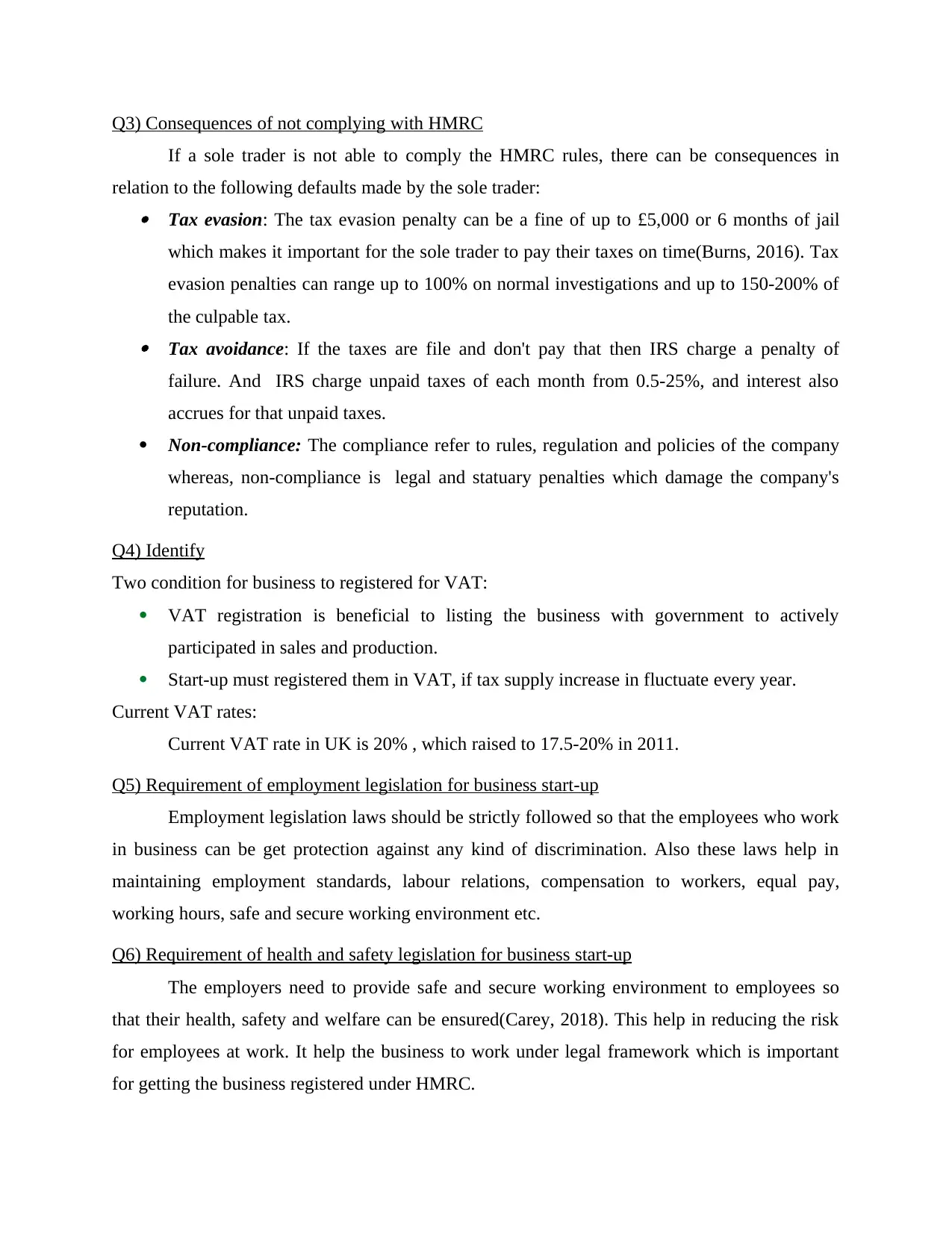
Q3) Consequences of not complying with HMRC
If a sole trader is not able to comply the HMRC rules, there can be consequences in
relation to the following defaults made by the sole trader: Tax evasion: The tax evasion penalty can be a fine of up to £5,000 or 6 months of jail
which makes it important for the sole trader to pay their taxes on time(Burns, 2016). Tax
evasion penalties can range up to 100% on normal investigations and up to 150-200% of
the culpable tax. Tax avoidance: If the taxes are file and don't pay that then IRS charge a penalty of
failure. And IRS charge unpaid taxes of each month from 0.5-25%, and interest also
accrues for that unpaid taxes.
Non-compliance: The compliance refer to rules, regulation and policies of the company
whereas, non-compliance is legal and statuary penalties which damage the company's
reputation.
Q4) Identify
Two condition for business to registered for VAT:
VAT registration is beneficial to listing the business with government to actively
participated in sales and production.
Start-up must registered them in VAT, if tax supply increase in fluctuate every year.
Current VAT rates:
Current VAT rate in UK is 20% , which raised to 17.5-20% in 2011.
Q5) Requirement of employment legislation for business start-up
Employment legislation laws should be strictly followed so that the employees who work
in business can be get protection against any kind of discrimination. Also these laws help in
maintaining employment standards, labour relations, compensation to workers, equal pay,
working hours, safe and secure working environment etc.
Q6) Requirement of health and safety legislation for business start-up
The employers need to provide safe and secure working environment to employees so
that their health, safety and welfare can be ensured(Carey, 2018). This help in reducing the risk
for employees at work. It help the business to work under legal framework which is important
for getting the business registered under HMRC.
If a sole trader is not able to comply the HMRC rules, there can be consequences in
relation to the following defaults made by the sole trader: Tax evasion: The tax evasion penalty can be a fine of up to £5,000 or 6 months of jail
which makes it important for the sole trader to pay their taxes on time(Burns, 2016). Tax
evasion penalties can range up to 100% on normal investigations and up to 150-200% of
the culpable tax. Tax avoidance: If the taxes are file and don't pay that then IRS charge a penalty of
failure. And IRS charge unpaid taxes of each month from 0.5-25%, and interest also
accrues for that unpaid taxes.
Non-compliance: The compliance refer to rules, regulation and policies of the company
whereas, non-compliance is legal and statuary penalties which damage the company's
reputation.
Q4) Identify
Two condition for business to registered for VAT:
VAT registration is beneficial to listing the business with government to actively
participated in sales and production.
Start-up must registered them in VAT, if tax supply increase in fluctuate every year.
Current VAT rates:
Current VAT rate in UK is 20% , which raised to 17.5-20% in 2011.
Q5) Requirement of employment legislation for business start-up
Employment legislation laws should be strictly followed so that the employees who work
in business can be get protection against any kind of discrimination. Also these laws help in
maintaining employment standards, labour relations, compensation to workers, equal pay,
working hours, safe and secure working environment etc.
Q6) Requirement of health and safety legislation for business start-up
The employers need to provide safe and secure working environment to employees so
that their health, safety and welfare can be ensured(Carey, 2018). This help in reducing the risk
for employees at work. It help the business to work under legal framework which is important
for getting the business registered under HMRC.
Paraphrase This Document
Need a fresh take? Get an instant paraphrase of this document with our AI Paraphraser
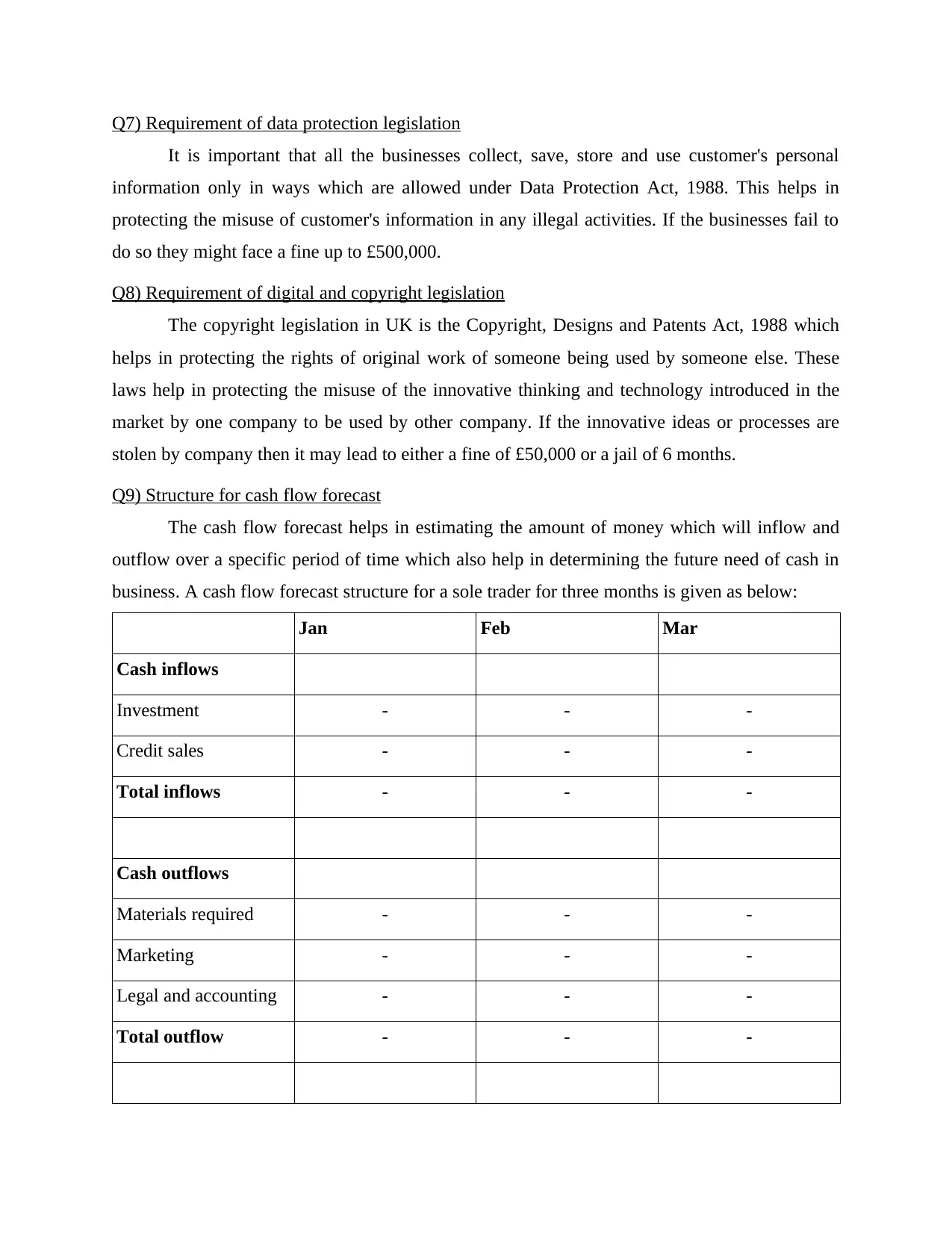
Q7) Requirement of data protection legislation
It is important that all the businesses collect, save, store and use customer's personal
information only in ways which are allowed under Data Protection Act, 1988. This helps in
protecting the misuse of customer's information in any illegal activities. If the businesses fail to
do so they might face a fine up to £500,000.
Q8) Requirement of digital and copyright legislation
The copyright legislation in UK is the Copyright, Designs and Patents Act, 1988 which
helps in protecting the rights of original work of someone being used by someone else. These
laws help in protecting the misuse of the innovative thinking and technology introduced in the
market by one company to be used by other company. If the innovative ideas or processes are
stolen by company then it may lead to either a fine of £50,000 or a jail of 6 months.
Q9) Structure for cash flow forecast
The cash flow forecast helps in estimating the amount of money which will inflow and
outflow over a specific period of time which also help in determining the future need of cash in
business. A cash flow forecast structure for a sole trader for three months is given as below:
Jan Feb Mar
Cash inflows
Investment - - -
Credit sales - - -
Total inflows - - -
Cash outflows
Materials required - - -
Marketing - - -
Legal and accounting - - -
Total outflow - - -
It is important that all the businesses collect, save, store and use customer's personal
information only in ways which are allowed under Data Protection Act, 1988. This helps in
protecting the misuse of customer's information in any illegal activities. If the businesses fail to
do so they might face a fine up to £500,000.
Q8) Requirement of digital and copyright legislation
The copyright legislation in UK is the Copyright, Designs and Patents Act, 1988 which
helps in protecting the rights of original work of someone being used by someone else. These
laws help in protecting the misuse of the innovative thinking and technology introduced in the
market by one company to be used by other company. If the innovative ideas or processes are
stolen by company then it may lead to either a fine of £50,000 or a jail of 6 months.
Q9) Structure for cash flow forecast
The cash flow forecast helps in estimating the amount of money which will inflow and
outflow over a specific period of time which also help in determining the future need of cash in
business. A cash flow forecast structure for a sole trader for three months is given as below:
Jan Feb Mar
Cash inflows
Investment - - -
Credit sales - - -
Total inflows - - -
Cash outflows
Materials required - - -
Marketing - - -
Legal and accounting - - -
Total outflow - - -
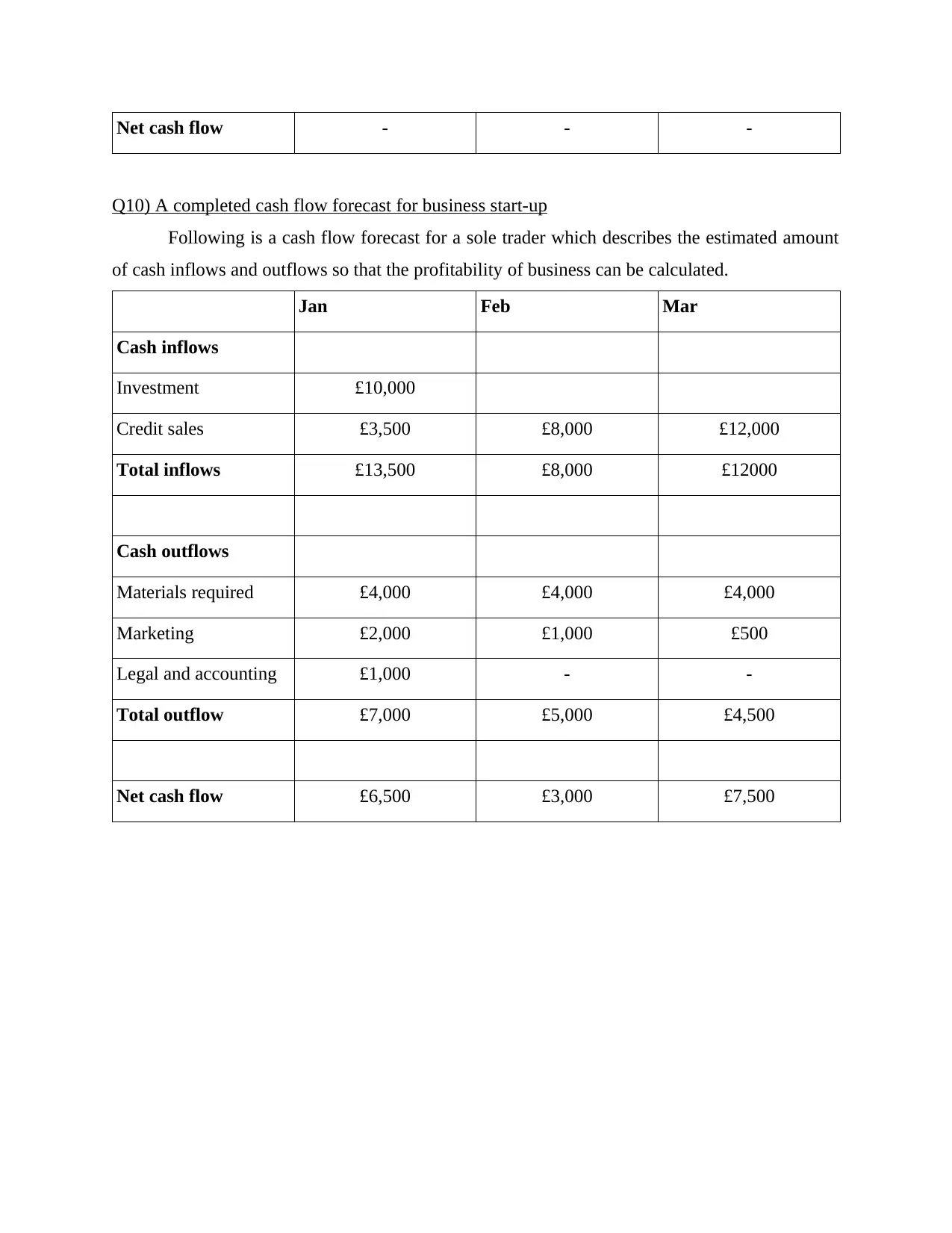
Net cash flow - - -
Q10) A completed cash flow forecast for business start-up
Following is a cash flow forecast for a sole trader which describes the estimated amount
of cash inflows and outflows so that the profitability of business can be calculated.
Jan Feb Mar
Cash inflows
Investment £10,000
Credit sales £3,500 £8,000 £12,000
Total inflows £13,500 £8,000 £12000
Cash outflows
Materials required £4,000 £4,000 £4,000
Marketing £2,000 £1,000 £500
Legal and accounting £1,000 - -
Total outflow £7,000 £5,000 £4,500
Net cash flow £6,500 £3,000 £7,500
Q10) A completed cash flow forecast for business start-up
Following is a cash flow forecast for a sole trader which describes the estimated amount
of cash inflows and outflows so that the profitability of business can be calculated.
Jan Feb Mar
Cash inflows
Investment £10,000
Credit sales £3,500 £8,000 £12,000
Total inflows £13,500 £8,000 £12000
Cash outflows
Materials required £4,000 £4,000 £4,000
Marketing £2,000 £1,000 £500
Legal and accounting £1,000 - -
Total outflow £7,000 £5,000 £4,500
Net cash flow £6,500 £3,000 £7,500
⊘ This is a preview!⊘
Do you want full access?
Subscribe today to unlock all pages.

Trusted by 1+ million students worldwide
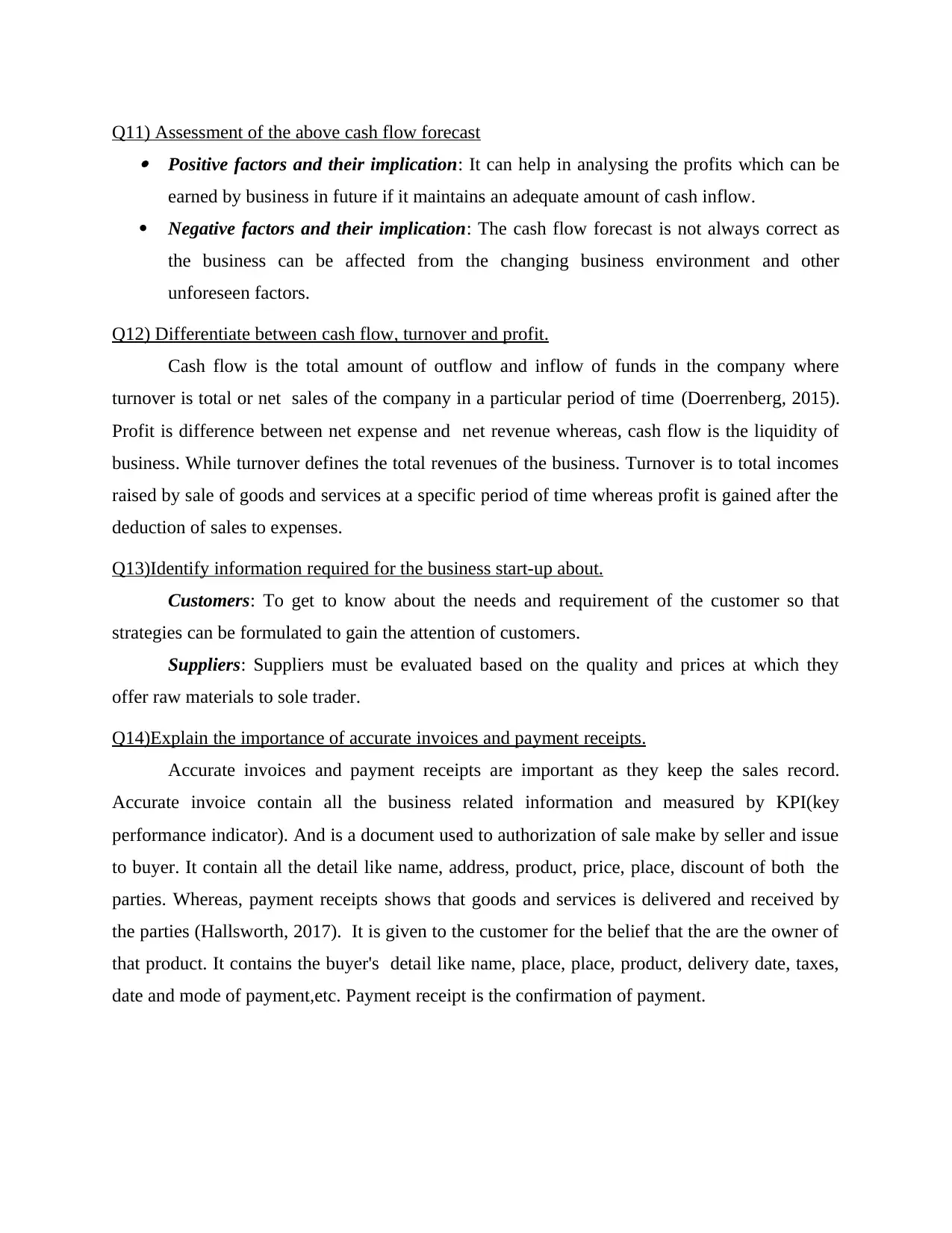
Q11) Assessment of the above cash flow forecast Positive factors and their implication: It can help in analysing the profits which can be
earned by business in future if it maintains an adequate amount of cash inflow.
Negative factors and their implication: The cash flow forecast is not always correct as
the business can be affected from the changing business environment and other
unforeseen factors.
Q12) Differentiate between cash flow, turnover and profit.
Cash flow is the total amount of outflow and inflow of funds in the company where
turnover is total or net sales of the company in a particular period of time (Doerrenberg, 2015).
Profit is difference between net expense and net revenue whereas, cash flow is the liquidity of
business. While turnover defines the total revenues of the business. Turnover is to total incomes
raised by sale of goods and services at a specific period of time whereas profit is gained after the
deduction of sales to expenses.
Q13)Identify information required for the business start-up about.
Customers: To get to know about the needs and requirement of the customer so that
strategies can be formulated to gain the attention of customers.
Suppliers: Suppliers must be evaluated based on the quality and prices at which they
offer raw materials to sole trader.
Q14)Explain the importance of accurate invoices and payment receipts.
Accurate invoices and payment receipts are important as they keep the sales record.
Accurate invoice contain all the business related information and measured by KPI(key
performance indicator). And is a document used to authorization of sale make by seller and issue
to buyer. It contain all the detail like name, address, product, price, place, discount of both the
parties. Whereas, payment receipts shows that goods and services is delivered and received by
the parties (Hallsworth, 2017). It is given to the customer for the belief that the are the owner of
that product. It contains the buyer's detail like name, place, place, product, delivery date, taxes,
date and mode of payment,etc. Payment receipt is the confirmation of payment.
earned by business in future if it maintains an adequate amount of cash inflow.
Negative factors and their implication: The cash flow forecast is not always correct as
the business can be affected from the changing business environment and other
unforeseen factors.
Q12) Differentiate between cash flow, turnover and profit.
Cash flow is the total amount of outflow and inflow of funds in the company where
turnover is total or net sales of the company in a particular period of time (Doerrenberg, 2015).
Profit is difference between net expense and net revenue whereas, cash flow is the liquidity of
business. While turnover defines the total revenues of the business. Turnover is to total incomes
raised by sale of goods and services at a specific period of time whereas profit is gained after the
deduction of sales to expenses.
Q13)Identify information required for the business start-up about.
Customers: To get to know about the needs and requirement of the customer so that
strategies can be formulated to gain the attention of customers.
Suppliers: Suppliers must be evaluated based on the quality and prices at which they
offer raw materials to sole trader.
Q14)Explain the importance of accurate invoices and payment receipts.
Accurate invoices and payment receipts are important as they keep the sales record.
Accurate invoice contain all the business related information and measured by KPI(key
performance indicator). And is a document used to authorization of sale make by seller and issue
to buyer. It contain all the detail like name, address, product, price, place, discount of both the
parties. Whereas, payment receipts shows that goods and services is delivered and received by
the parties (Hallsworth, 2017). It is given to the customer for the belief that the are the owner of
that product. It contains the buyer's detail like name, place, place, product, delivery date, taxes,
date and mode of payment,etc. Payment receipt is the confirmation of payment.
Paraphrase This Document
Need a fresh take? Get an instant paraphrase of this document with our AI Paraphraser
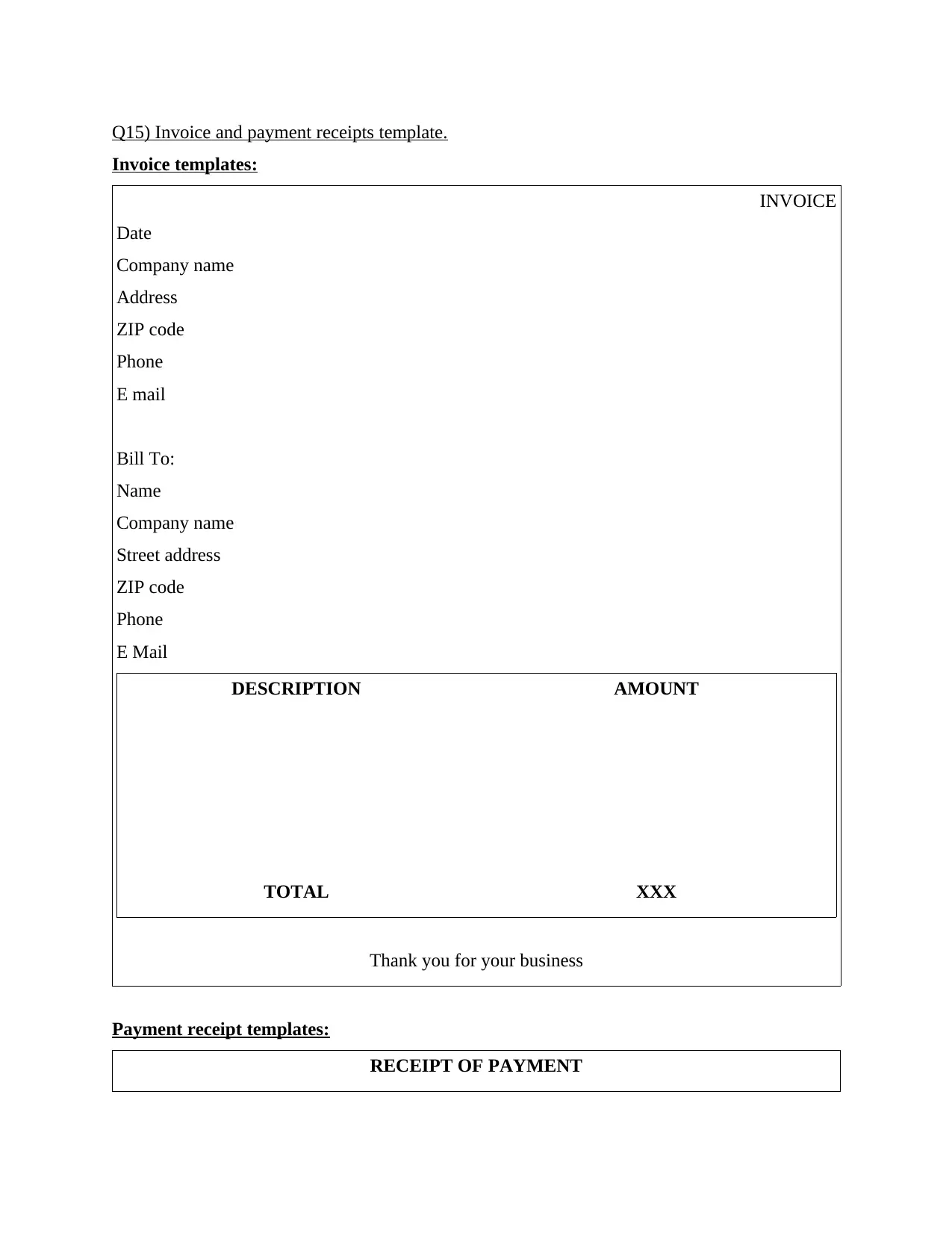
Q15) Invoice and payment receipts template.
Invoice templates:
INVOICE
Date
Company name
Address
ZIP code
Phone
E mail
Bill To:
Name
Company name
Street address
ZIP code
Phone
E Mail
DESCRIPTION AMOUNT
TOTAL XXX
Thank you for your business
Payment receipt templates:
RECEIPT OF PAYMENT
Invoice templates:
INVOICE
Date
Company name
Address
ZIP code
Phone
E mail
Bill To:
Name
Company name
Street address
ZIP code
Phone
E Mail
DESCRIPTION AMOUNT
TOTAL XXX
Thank you for your business
Payment receipt templates:
RECEIPT OF PAYMENT
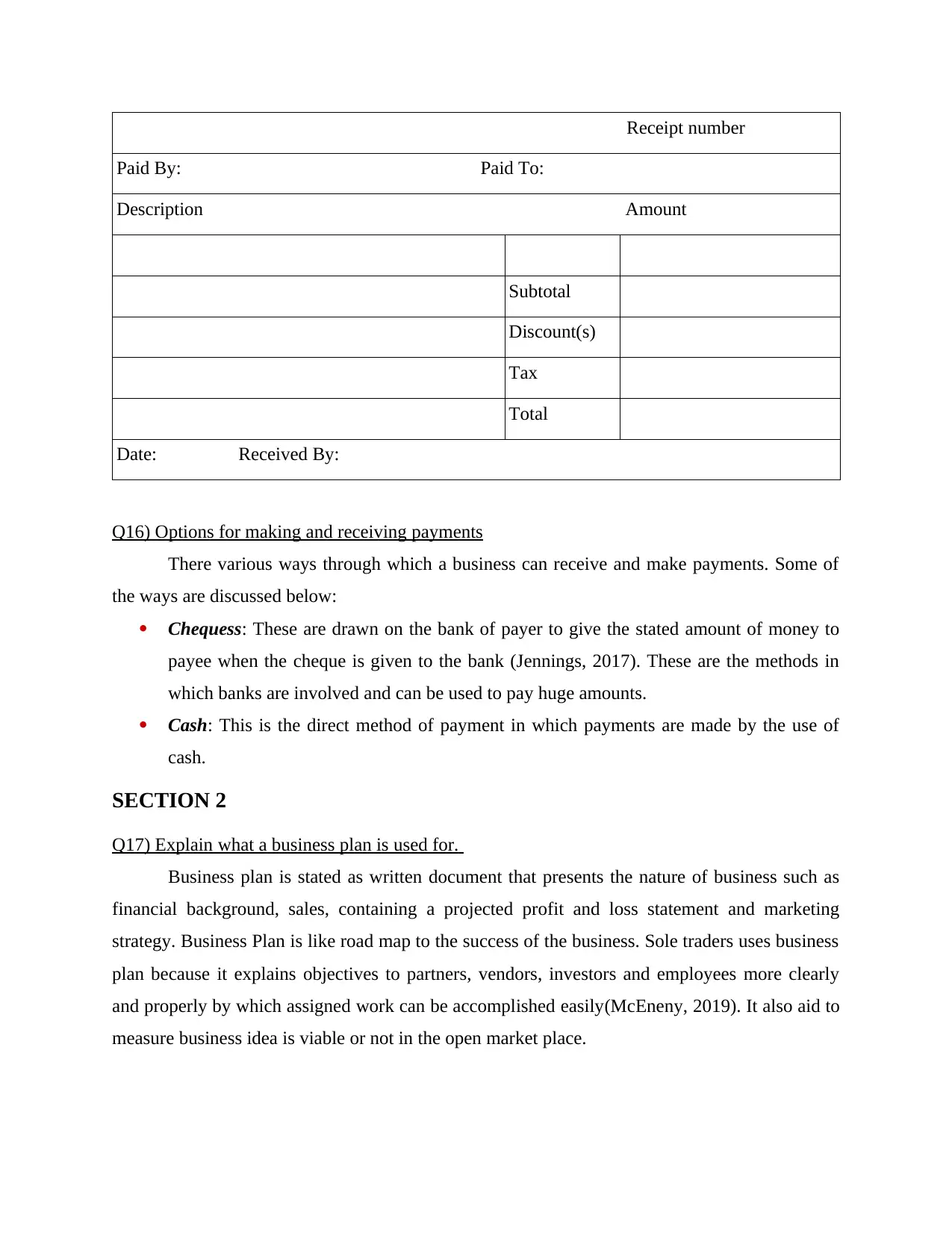
Receipt number
Paid By: Paid To:
Description Amount
Subtotal
Discount(s)
Tax
Total
Date: Received By:
Q16) Options for making and receiving payments
There various ways through which a business can receive and make payments. Some of
the ways are discussed below:
Chequess: These are drawn on the bank of payer to give the stated amount of money to
payee when the cheque is given to the bank (Jennings, 2017). These are the methods in
which banks are involved and can be used to pay huge amounts.
Cash: This is the direct method of payment in which payments are made by the use of
cash.
SECTION 2
Q17) Explain what a business plan is used for.
Business plan is stated as written document that presents the nature of business such as
financial background, sales, containing a projected profit and loss statement and marketing
strategy. Business Plan is like road map to the success of the business. Sole traders uses business
plan because it explains objectives to partners, vendors, investors and employees more clearly
and properly by which assigned work can be accomplished easily(McEneny, 2019). It also aid to
measure business idea is viable or not in the open market place.
Paid By: Paid To:
Description Amount
Subtotal
Discount(s)
Tax
Total
Date: Received By:
Q16) Options for making and receiving payments
There various ways through which a business can receive and make payments. Some of
the ways are discussed below:
Chequess: These are drawn on the bank of payer to give the stated amount of money to
payee when the cheque is given to the bank (Jennings, 2017). These are the methods in
which banks are involved and can be used to pay huge amounts.
Cash: This is the direct method of payment in which payments are made by the use of
cash.
SECTION 2
Q17) Explain what a business plan is used for.
Business plan is stated as written document that presents the nature of business such as
financial background, sales, containing a projected profit and loss statement and marketing
strategy. Business Plan is like road map to the success of the business. Sole traders uses business
plan because it explains objectives to partners, vendors, investors and employees more clearly
and properly by which assigned work can be accomplished easily(McEneny, 2019). It also aid to
measure business idea is viable or not in the open market place.
⊘ This is a preview!⊘
Do you want full access?
Subscribe today to unlock all pages.

Trusted by 1+ million students worldwide
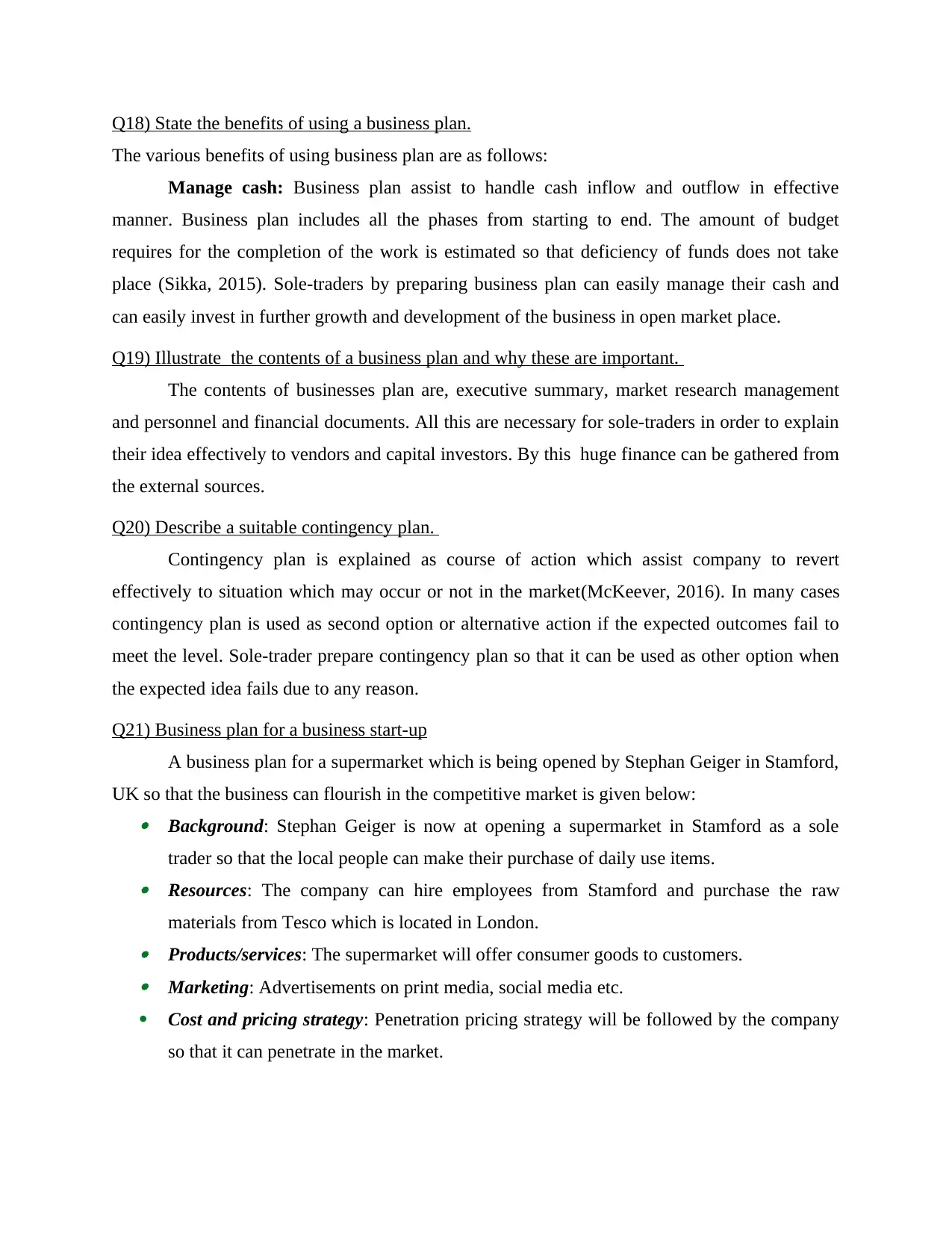
Q18) State the benefits of using a business plan.
The various benefits of using business plan are as follows:
Manage cash: Business plan assist to handle cash inflow and outflow in effective
manner. Business plan includes all the phases from starting to end. The amount of budget
requires for the completion of the work is estimated so that deficiency of funds does not take
place (Sikka, 2015). Sole-traders by preparing business plan can easily manage their cash and
can easily invest in further growth and development of the business in open market place.
Q19) Illustrate the contents of a business plan and why these are important.
The contents of businesses plan are, executive summary, market research management
and personnel and financial documents. All this are necessary for sole-traders in order to explain
their idea effectively to vendors and capital investors. By this huge finance can be gathered from
the external sources.
Q20) Describe a suitable contingency plan.
Contingency plan is explained as course of action which assist company to revert
effectively to situation which may occur or not in the market(McKeever, 2016). In many cases
contingency plan is used as second option or alternative action if the expected outcomes fail to
meet the level. Sole-trader prepare contingency plan so that it can be used as other option when
the expected idea fails due to any reason.
Q21) Business plan for a business start-up
A business plan for a supermarket which is being opened by Stephan Geiger in Stamford,
UK so that the business can flourish in the competitive market is given below: Background: Stephan Geiger is now at opening a supermarket in Stamford as a sole
trader so that the local people can make their purchase of daily use items. Resources: The company can hire employees from Stamford and purchase the raw
materials from Tesco which is located in London. Products/services: The supermarket will offer consumer goods to customers. Marketing: Advertisements on print media, social media etc.
Cost and pricing strategy: Penetration pricing strategy will be followed by the company
so that it can penetrate in the market.
The various benefits of using business plan are as follows:
Manage cash: Business plan assist to handle cash inflow and outflow in effective
manner. Business plan includes all the phases from starting to end. The amount of budget
requires for the completion of the work is estimated so that deficiency of funds does not take
place (Sikka, 2015). Sole-traders by preparing business plan can easily manage their cash and
can easily invest in further growth and development of the business in open market place.
Q19) Illustrate the contents of a business plan and why these are important.
The contents of businesses plan are, executive summary, market research management
and personnel and financial documents. All this are necessary for sole-traders in order to explain
their idea effectively to vendors and capital investors. By this huge finance can be gathered from
the external sources.
Q20) Describe a suitable contingency plan.
Contingency plan is explained as course of action which assist company to revert
effectively to situation which may occur or not in the market(McKeever, 2016). In many cases
contingency plan is used as second option or alternative action if the expected outcomes fail to
meet the level. Sole-trader prepare contingency plan so that it can be used as other option when
the expected idea fails due to any reason.
Q21) Business plan for a business start-up
A business plan for a supermarket which is being opened by Stephan Geiger in Stamford,
UK so that the business can flourish in the competitive market is given below: Background: Stephan Geiger is now at opening a supermarket in Stamford as a sole
trader so that the local people can make their purchase of daily use items. Resources: The company can hire employees from Stamford and purchase the raw
materials from Tesco which is located in London. Products/services: The supermarket will offer consumer goods to customers. Marketing: Advertisements on print media, social media etc.
Cost and pricing strategy: Penetration pricing strategy will be followed by the company
so that it can penetrate in the market.
Paraphrase This Document
Need a fresh take? Get an instant paraphrase of this document with our AI Paraphraser
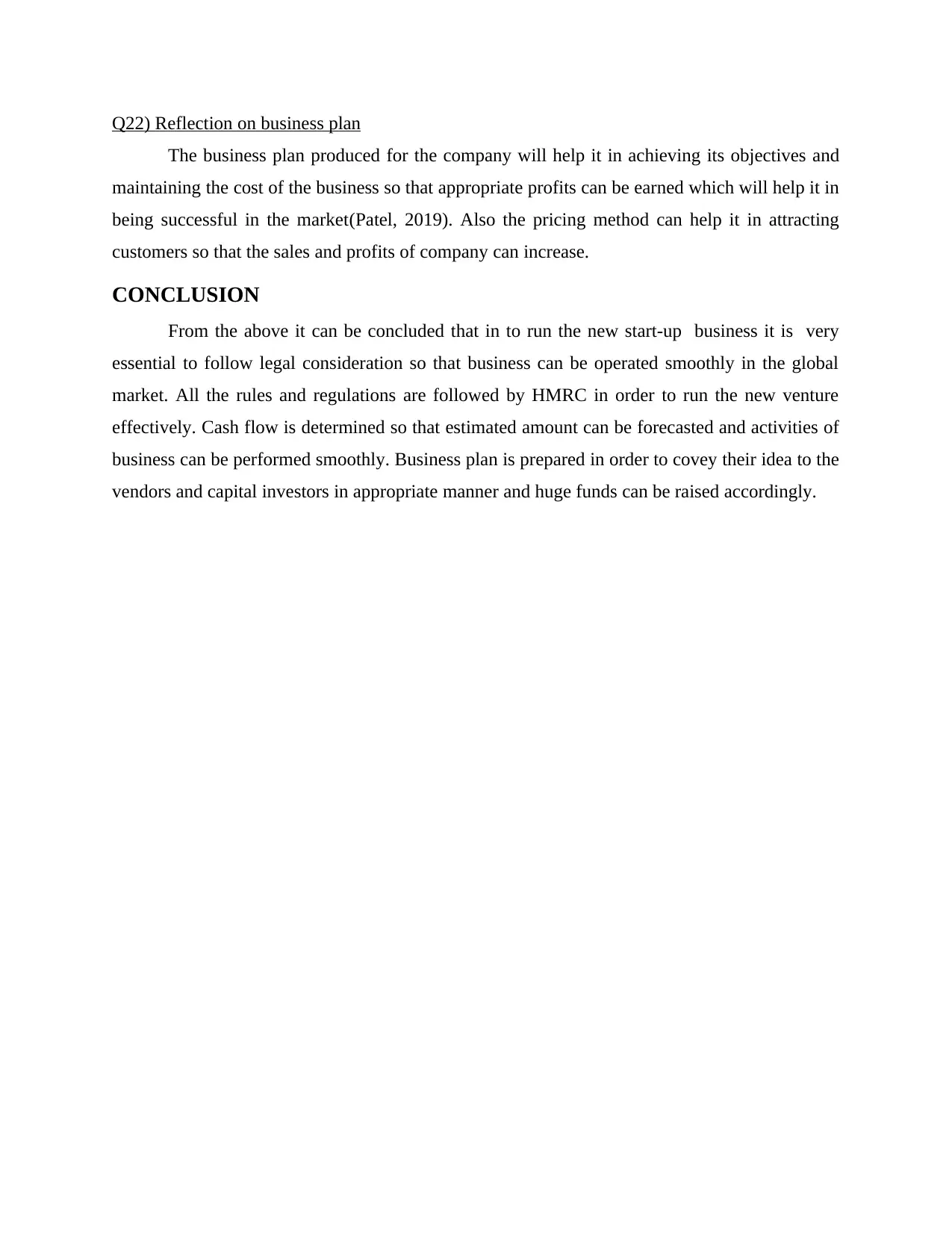
Q22) Reflection on business plan
The business plan produced for the company will help it in achieving its objectives and
maintaining the cost of the business so that appropriate profits can be earned which will help it in
being successful in the market(Patel, 2019). Also the pricing method can help it in attracting
customers so that the sales and profits of company can increase.
CONCLUSION
From the above it can be concluded that in to run the new start-up business it is very
essential to follow legal consideration so that business can be operated smoothly in the global
market. All the rules and regulations are followed by HMRC in order to run the new venture
effectively. Cash flow is determined so that estimated amount can be forecasted and activities of
business can be performed smoothly. Business plan is prepared in order to covey their idea to the
vendors and capital investors in appropriate manner and huge funds can be raised accordingly.
The business plan produced for the company will help it in achieving its objectives and
maintaining the cost of the business so that appropriate profits can be earned which will help it in
being successful in the market(Patel, 2019). Also the pricing method can help it in attracting
customers so that the sales and profits of company can increase.
CONCLUSION
From the above it can be concluded that in to run the new start-up business it is very
essential to follow legal consideration so that business can be operated smoothly in the global
market. All the rules and regulations are followed by HMRC in order to run the new venture
effectively. Cash flow is determined so that estimated amount can be forecasted and activities of
business can be performed smoothly. Business plan is prepared in order to covey their idea to the
vendors and capital investors in appropriate manner and huge funds can be raised accordingly.
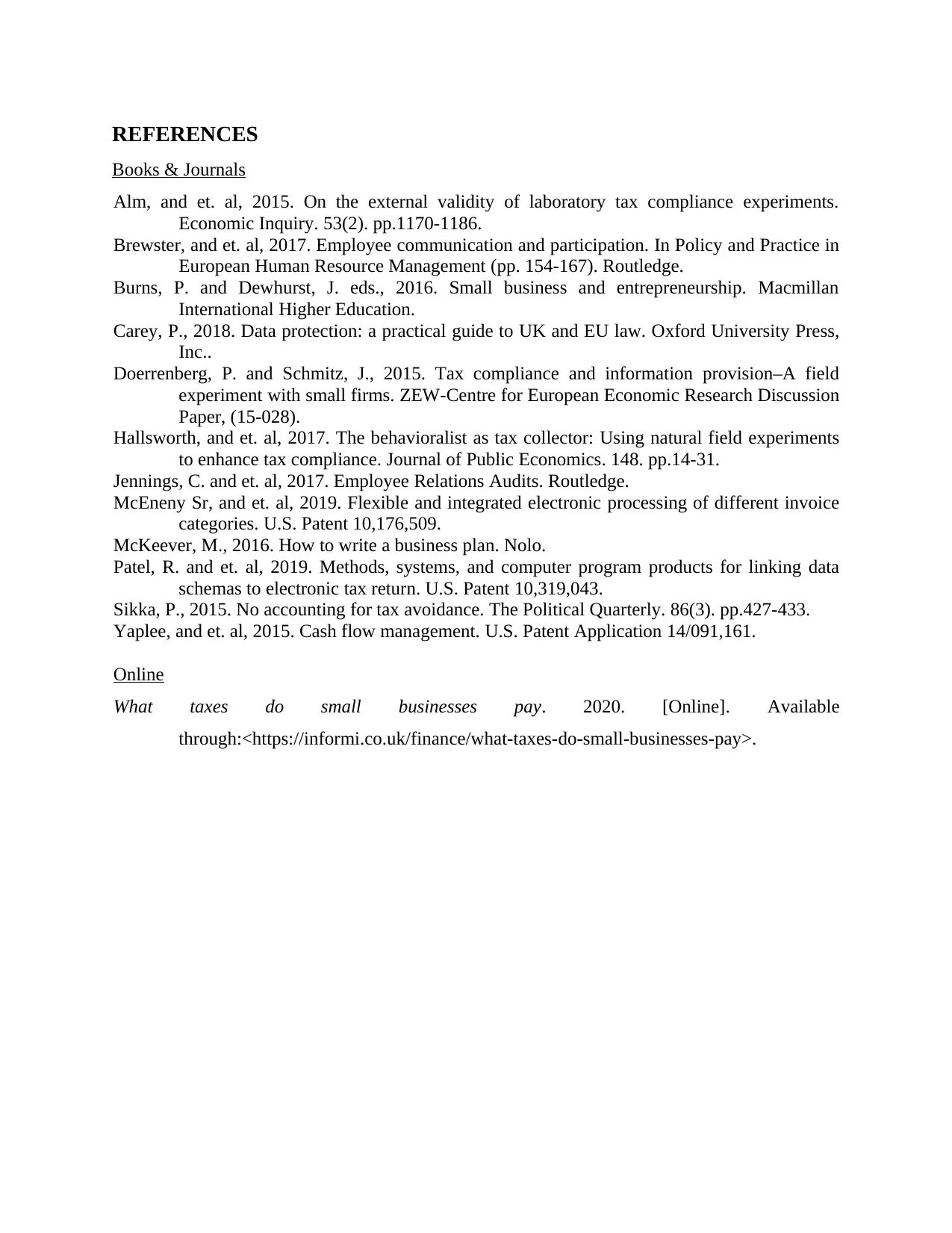
REFERENCES
Books & Journals
Alm, and et. al, 2015. On the external validity of laboratory tax compliance experiments.
Economic Inquiry. 53(2). pp.1170-1186.
Brewster, and et. al, 2017. Employee communication and participation. In Policy and Practice in
European Human Resource Management (pp. 154-167). Routledge.
Burns, P. and Dewhurst, J. eds., 2016. Small business and entrepreneurship. Macmillan
International Higher Education.
Carey, P., 2018. Data protection: a practical guide to UK and EU law. Oxford University Press,
Inc..
Doerrenberg, P. and Schmitz, J., 2015. Tax compliance and information provision–A field
experiment with small firms. ZEW-Centre for European Economic Research Discussion
Paper, (15-028).
Hallsworth, and et. al, 2017. The behavioralist as tax collector: Using natural field experiments
to enhance tax compliance. Journal of Public Economics. 148. pp.14-31.
Jennings, C. and et. al, 2017. Employee Relations Audits. Routledge.
McEneny Sr, and et. al, 2019. Flexible and integrated electronic processing of different invoice
categories. U.S. Patent 10,176,509.
McKeever, M., 2016. How to write a business plan. Nolo.
Patel, R. and et. al, 2019. Methods, systems, and computer program products for linking data
schemas to electronic tax return. U.S. Patent 10,319,043.
Sikka, P., 2015. No accounting for tax avoidance. The Political Quarterly. 86(3). pp.427-433.
Yaplee, and et. al, 2015. Cash flow management. U.S. Patent Application 14/091,161.
Online
What taxes do small businesses pay. 2020. [Online]. Available
through:<https://informi.co.uk/finance/what-taxes-do-small-businesses-pay>.
Books & Journals
Alm, and et. al, 2015. On the external validity of laboratory tax compliance experiments.
Economic Inquiry. 53(2). pp.1170-1186.
Brewster, and et. al, 2017. Employee communication and participation. In Policy and Practice in
European Human Resource Management (pp. 154-167). Routledge.
Burns, P. and Dewhurst, J. eds., 2016. Small business and entrepreneurship. Macmillan
International Higher Education.
Carey, P., 2018. Data protection: a practical guide to UK and EU law. Oxford University Press,
Inc..
Doerrenberg, P. and Schmitz, J., 2015. Tax compliance and information provision–A field
experiment with small firms. ZEW-Centre for European Economic Research Discussion
Paper, (15-028).
Hallsworth, and et. al, 2017. The behavioralist as tax collector: Using natural field experiments
to enhance tax compliance. Journal of Public Economics. 148. pp.14-31.
Jennings, C. and et. al, 2017. Employee Relations Audits. Routledge.
McEneny Sr, and et. al, 2019. Flexible and integrated electronic processing of different invoice
categories. U.S. Patent 10,176,509.
McKeever, M., 2016. How to write a business plan. Nolo.
Patel, R. and et. al, 2019. Methods, systems, and computer program products for linking data
schemas to electronic tax return. U.S. Patent 10,319,043.
Sikka, P., 2015. No accounting for tax avoidance. The Political Quarterly. 86(3). pp.427-433.
Yaplee, and et. al, 2015. Cash flow management. U.S. Patent Application 14/091,161.
Online
What taxes do small businesses pay. 2020. [Online]. Available
through:<https://informi.co.uk/finance/what-taxes-do-small-businesses-pay>.
⊘ This is a preview!⊘
Do you want full access?
Subscribe today to unlock all pages.

Trusted by 1+ million students worldwide
1 out of 12
Related Documents
Your All-in-One AI-Powered Toolkit for Academic Success.
+13062052269
info@desklib.com
Available 24*7 on WhatsApp / Email
![[object Object]](/_next/static/media/star-bottom.7253800d.svg)
Unlock your academic potential
Copyright © 2020–2025 A2Z Services. All Rights Reserved. Developed and managed by ZUCOL.





